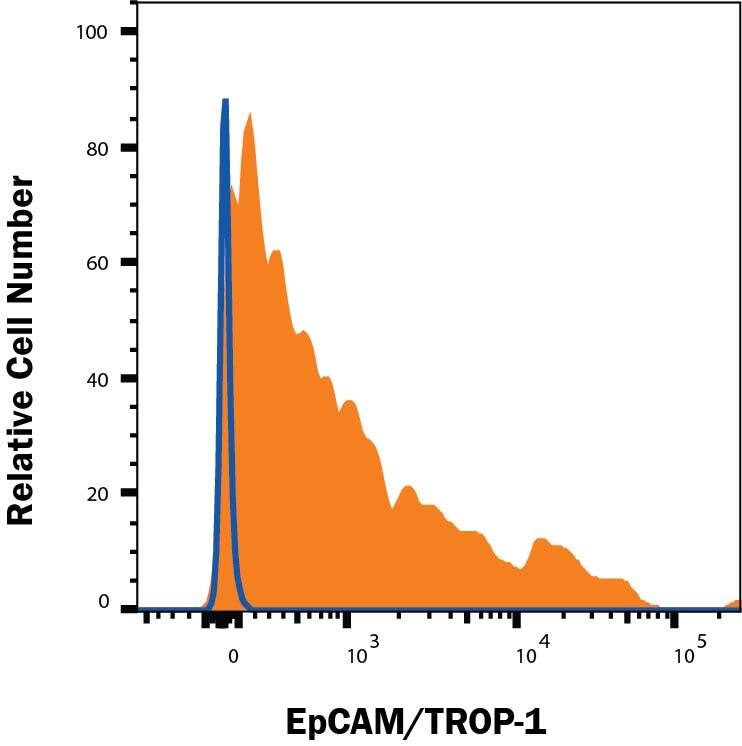Mouse
EpCAM/TROP-1 PE-conjugated Antibody
R&D Systems, part of Bio-Techne | Catalog # FAB8998P
Recombinant Monoclonal Antibody.


Conjugate
Catalog #
Key Product Details
Species Reactivity
Mouse
Applications
Flow Cytometry
Label
Phycoerythrin (Excitation = 488 nm, Emission = 565-605 nm)
Antibody Source
Recombinant Monoclonal Rat IgG2A Clone # G8.8R
Product Specifications
Immunogen
TE-71 Thymic epithelial cell line
Specificity
Detects mouse EpCAM/TROP-1 in flow cytometry.
Clonality
Monoclonal
Host
Rat
Isotype
IgG2A
Scientific Data Images for Mouse EpCAM/TROP-1 PE-conjugated Antibody
Detection of EpCAM/TROP‑1 in 4T1 Mouse Cell Line by Flow Cytometry.
4T1 mouse breast cancer cell line was stained with Rat Anti-Mouse EpCAM/TROP-1 PE-conjugated Monoclonal Antibody (Catalog # FAB8998P, filled histogram) or isotype control antibody (Catalog # IC006P, open histogram). View our protocol for Staining Membrane-associated Proteins.Detection of EpCAM/TROP‑1 in mIMCD3 Mouse Cell Line by Flow Cytometry.
mIMCD3 mouse kidney cell line was stained with Rat Anti-Mouse EpCAM/TROP-1 PE-conjugated Monoclonal Antibody (Catalog # FAB8998P, filled histogram) or isotype control antibody (IC006P, open histogram). View our protocol for Staining Membrane-associated Proteins.Applications for Mouse EpCAM/TROP-1 PE-conjugated Antibody
Application
Recommended Usage
Flow Cytometry
10 µL/106 cells
Sample: 4T1 mouse breast cancer cell line and mIMCD3 mouse kidney cell line
Sample: 4T1 mouse breast cancer cell line and mIMCD3 mouse kidney cell line
Reviewed Applications
Read 1 review rated 3 using FAB8998P in the following applications:
Formulation, Preparation, and Storage
Purification
Protein A or G purified from cell culture supernatant
Formulation
Supplied
in a saline solution containing BSA and Sodium Azide.
Shipping
The product is shipped with polar packs. Upon receipt, store it immediately at the temperature recommended below.
Stability & Storage
Protect from light. Do not freeze.
- 12 months from date of receipt, 2 to 8 °C as supplied.
Background: EpCAM/TROP1
References
- Schnell, U. et al. (2013) Biochim. Biophys. Acta 1828:1989.
- Martowicz, A. et al. (2015) Histol. Histopathol. Oct 23:11678 [ePub ahead of print].
- Schnell, U. et al. (2013) Biosci. Rep. 33:e00030.
- Hachmeister, M. et al. (2013) PLoS ONE 8:e71836.
Long Name
Epithelial Cell Adhesion Molecule
Alternate Names
17-1A, CD326, GA733-2, gp40, KS1/4, M4S1, TACSTD1, TROP1
Gene Symbol
EPCAM
Additional EpCAM/TROP1 Products
Product Documents for Mouse EpCAM/TROP-1 PE-conjugated Antibody
Product Specific Notices for Mouse EpCAM/TROP-1 PE-conjugated Antibody
For research use only
